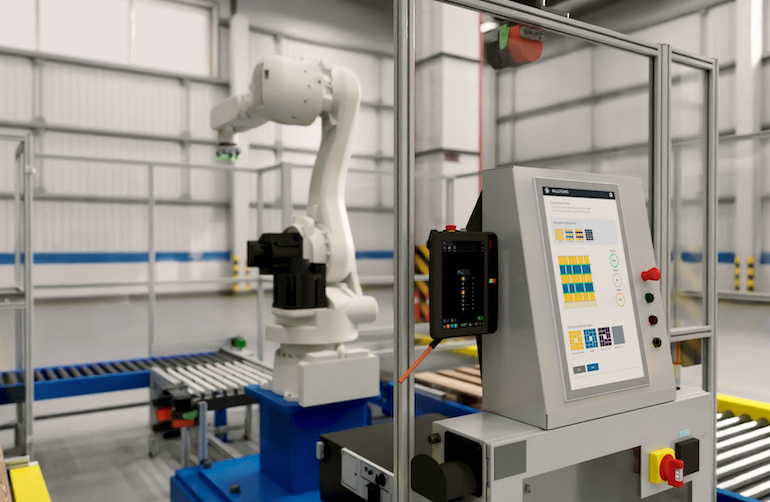|
Listen to this article  |

Toyota will use robots simulated on NVIDIA Isaac Sim and controlled by READY Robotics’ ForgeOS. Source: NVIDIA
READY Robotics today announced that it is collaborating with Toyota Motor Corp. and NVIDIA Corp. to enhance safety and efficiency in automotive production. Toyota will use READY’s ForgeOS with NVIDIA Isaac Sim to build a simulated robotic programming environment for its aluminum hot forging production lines.
Columbus, Ohio-based READY Robotics said its ForgeOS operating system makes industrial robot programming easier and more accessible to manufacturers of all sizes. Santa Clara, Calif.-based NVIDIA described Isaac Sim as an extensible application developed on its Omniverse platform for simulating, developing, and testing robots.
Typically, programming robots for forging requires the metal parts to remain hot during the process, posing significant safety challenges, noted the company. By integrating ForgeOS and Isaac Sim, programming can now be done in a visual and physics-realistic simulated environment. This eliminates the risks associated with hot parts, said READY Robotics.
ForgeOS and Isaac Sim bridge monitoring gap
The integration of ForgeOS with NVIDIA Isaac Sim’s simulation environments allows Toyota to quickly program and optimize complex robotic forging routines, said the partners. Once proven in simulation, the programs can be transferred to the live production workcell, eliminating the need to program the physical installation and safety concerns around hot parts.
Since ForgeOS controls both the simulation and physical work cell, a program can be transferred and updated in seconds, minimizing downtime and making the workcell easier to maintain, claimed READY Robotics.
This “sim-to-real” workflow also enables ForgeOS to relay real-time production data from the cell on the factory floor back to the original Isaac Sim simulation. This forms a digital twin of the live cell, enabling visualizations of its current state and facilitating greater monitoring and oversight, said READY Robotics and NVIDIA.
“Simulating industrial processes in high fidelity prior to their real-world deployment can greatly improve productivity and safety while reducing costs,” said Deepu Talla, vice president of embedded and edge computing at NVIDIA. “The collaboration between Toyota and READY Robotics is a great example of the pioneering use of technology, such as NVIDIA Isaac Sim, to unlock industrial digitalization possibilities in manufacturing.”
Toyota expects iterative process improvements
“Toyota’s collaboration with READY Robotics and NVIDIA is poised to create a new frontier for how robotic automation is programmed and deployed with greater efficiency, usability, and safety,” said the companies. “It opens the opportunity for production data to be captured from automation systems for use in process monitoring and improvement, or even artificial intelligence applications.”
ForgeOS and NVIDIA Isaac Sim together allow users to rapidly create realistic programs for challenging programming tasks, especially those where safety is a concern, said READY Robotics.
“NVIDIA provides the tools needed to help our programs reflect real-world situations, and ForgeOS provides the connection from this simulation to the real cell and back,” noted Dr. Kel Guerin, chief innovation officer at READY Robotics. “We are pleased to be working with SCSK, a leading Japanese IT services company and NVIDIA Omniverse partner, to bring this solution to Toyota.”
Kazuhiro Suzuki, group manager of Toyota’s Raw Materials Development Division, stated: “The unique architecture of ForgeOS allows for the sim-to-real workflow we need for this production line because it bridges NVIDIA Isaac Sim’s simulation capabilities with the control of our physical system.”
“This means we can program in simulation, transfer that program, and then use ForgeOS to capture live production data and iteratively improve our processes,” he added. “We are looking towards a future where machine learning and AI allow for advancements in our manufacturing processes, but everything starts with improving our current processes, all while simultaneously extracting the data out of the factory into simulation where it is useful.”
Credit: Source link


Comments are closed.